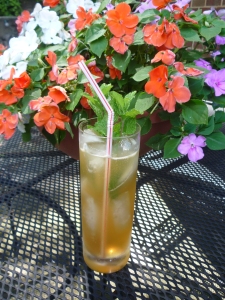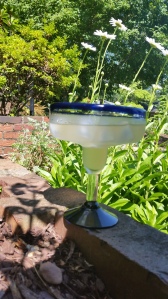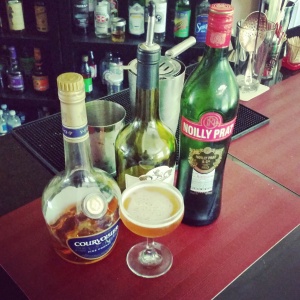 A lot of folks, when they think of tiki, they think of overly sweet drinks served in novelty mugs with over-the-top garnishes. It’s all presentation, you might say, and not really about the drink. That’s not so, according to local tiki expert Joey Schmidt, also known as Joey from Leeds or JFL, who writes the Rated-R Cocktails blog. Tiki, in fact, is tremendously misunderstood and underrated by bartenders who are either too uninformed or too lazy to appreciate its true depth. When tiki is done well, it is as much of an art as any other craft cocktail.
A lot of folks, when they think of tiki, they think of overly sweet drinks served in novelty mugs with over-the-top garnishes. It’s all presentation, you might say, and not really about the drink. That’s not so, according to local tiki expert Joey Schmidt, also known as Joey from Leeds or JFL, who writes the Rated-R Cocktails blog. Tiki, in fact, is tremendously misunderstood and underrated by bartenders who are either too uninformed or too lazy to appreciate its true depth. When tiki is done well, it is as much of an art as any other craft cocktail.
WT: You were talking to me earlier about the five pillars of flavor in a tiki drink. What are those?
JFL: Just like any cocktail, you can break them down into component parts, but in tiki, you don’t necessarily pick out each and every flavor. You pick out a marriage of flavors—a beginning, middle, and end. Take, for example, Planters Punch, which is the building block of tiki drinks and the building block for Daiquiris as well. You have strong, weak, sour, sweet, and there’s a fifth pillar that you don’t see in that rhyme that’s in every article—spice. Spice is what makes it tiki over simply being Caribbean. The key component into making a tiki drink custom—and I think a lot of people have trouble with this—is you have to have all those elements in play, and you have to remember that a tiki drink should be more sour than sweet. It’s okay for it to be balanced, equal parts sour and sweet, but you should definitely not put more sugar in it than you have sour, unless you’re making a Painkiller, which breaks all the rules.
WT: Tiki drinks can often have 10 or 12 ingredients in them.
JFL: You can, but more ingredients doesn’t necessarily the better drink make.
WT: We know it’s a long story, but summarize for us, if you can, the origins of tiki.
JFL: To start off plainly, tiki is an evolved sour. No matter what you might think, a tiki drink has to have some form of citrus juice in it, which technically leaves the Piña Colada out (there are arguments about that).
Tiki started in the 1930s, just after prohibition, and bars were starting to open back up, but most of the bartenders had moved on to other careers or moved to Europe. So you had a lot of bar guides coming out of varied quality. One man, Ernest Raymond Beaumont Gantt—or, as he later came to be known, Donn Beach—was in California at that point. His granddad ran rum during Prohibition, and he would go on the boat with him. So he got to try the Planters Punch and the Daiquiri and all these drinks from the Caribbean. He had a good knowledge of them, and he had gotten to try all these rums. He had knowledge that a lot of other bartenders didn’t have at that time because the Caribbean was not a big tourist destination then, other than Cuba. It was a dirty place where respectable people didn’t go.
Then, Don had the choice that he could go around the globe or he could go to college. Donn, being the beach bum that he was, went around the world, especially around Asia. So when it came time for him to open a bar, he had a unique idea. It was the law in California then that you had to serve food if you served alcohol. He didn’t know this, so at the last minute, they set up a burner , a wok, and a vent, and he got somebody from Chinatown to cook for him. And so thus we associate Chinese food with tiki drinks.
Eventually, it became big. He married a waitress named Sunny Sund, and she had a mind for business. While Donn was basically an artistic guy who loved making these drinks, she was a business minded woman. They bought a hotel that became Don the Beachcomber, with a gift shop and guest rooms. It blew up big. This was a hotspot for celebrities—Clark Gable, Marlene Dietrich. It was top-hat and tails, black tie. This was the place to be in the ‘30s. Eventually, they got divorced. Sunny Sund got the rights to everything they had, and Donn left for Hawaii, which I assume was just fine for him. He opened places like Colonel Beach’s Plantation Steakhouse, so he got to keep doing his drinks over there. But it was because of him, and his knowledge of rum, and his knowledge of Caribbean drinks that we have tiki drinks.
In Potions of the Caribbean, Jeff Berry talks about how these Caribbean drinks were given a South Seas/Asian/Polynesian theme, when really there are no drinks from that area. The only spirit really is Cava, which is a chewed up root that’s spit back out and buried—not really that appetizing. So most Asian drinks are actually Caribbean drinks, oddly enough.
Then comes Trader Vic. Tiki had started becoming big. Trader Vic was an entrepreneur who was a real go-getter. That man was salty, salty to the core. He sat at Don the Beachcomber’s for a whole week and watched how they mixed drinks, and then he had the idea that “hey, I could do this.” But he had no idea how to make the drinks. So then he goes on a tour of the Caribbean and sits down at a lot of the great bars out there, like the Floradita.
WT: That’s the bar in Havana where Hemingway used to hang out.
JFL: Right. He comes back with the knowledge and puts his own unique spin on it. It’s still tiki, but you can definitely tell a Vic drink from a Donn drink, even though there’s this whole argument over which of them invented the Mai Tai, which I couldn’t care less about. Anyway, this continued on through World War II, and Hawaii becoming a state really gave it a huge boost. I think that the reason it became such a craze over the years is because people were fed up with horrible things, like the Depression and wars and atomic threats, that they just wanted to escape.
WT: Why do we use the word tiki? I know it has to do with the Polynesian theme, but what more can you tell us about that?
JFL: Originally, nobody used the term tiki. They were Polynesian drinks, the drinks you got at a Chinese restaurant, Polynesian Pop, I believe was a term used at some point. But tiki was a word that started to be used in the late ‘90s when tiki started to become a big thing again. And, by the way, I want to make clear that Jeff Berry is the reason why any of us are doing this. Without Berry, there would be a few forgotten Trader Vics and the Mai Tai and not much else. So we can really all thank Jeff for that. But tiki started to come about because in popular culture, like in some Brady Bunch episodes, the word tiki was used to talk about Polynesian idols.
WT: So there’s a nostalgic kitch association.
JFL: And you do see the word tiki in some drink books. Where umbrella drink became the pejorative word for beach drinks in the ‘80s, tiki became a word to separate out the two. They were once called exotic cocktails. One person coined the term tropikal with a k.
WT: Other than Jeff Berry, who are some of the modern writers we should read to learn more about tiki?
JFL: Phoebe Beach, Donn’s widow, put out a book with her new husband based on Donn’s notes. I wouldn’t use it as a Bible, but it’s a great reference if you’ve read Jeff’s books and want to branch out. Great pictures, great anecdotes. But the recipes kind of read like if my mother went through my notes after I died and tried to tell people how I made those drinks. It sort of feels like that. Outside that, Zombie Horde. It’s not a Bible either. There’s good stuff and bad stuff in there. There’s Rated-R Cocktails dot com. I hear that guy’s a sexy man.
Trader Vic wrote a lot of books. A lot of them are out of print. The one that’s out now is called Trader Vic Party something… you can find it on Amazon.
WT: Yeah, I have that book. There are some recipes that are a little questionable—using pre-fab mixes and things like that.
JFL: Vic was big into that, even in the ‘60s. He was one of the fathers of prefab mixes.
WT: Right, he marketed his own Mai Tai mix.
JFL: And Mai Tai blended rum. It’s hard to hate on Vic because I love reading his actual words. I was given a cookbook he wrote in the ‘60s (thanks to Kelsey Crenshaw), and it’s so great to read his writing. It’s so clear that he wrote it. It is so salty and so surly. And he was an experimenter. He would try stuff out, stuff that wouldn’t make it in the restaurant, he’d put it in a book to use as filler. I would definitely say go check out his book, even the Trader Vic Party book because once you’ve seen how some of these drinks come together, you can probably figure out what was in that mix.
Martin Cate from Smuggler’s Cove has done a series of YouTube videos, and one of them actually has Trader Vic’s Navy Grog, which is probably Trader Vic’s greatest creation aside from the Tortuga, in my opinion. This is one Jeff agonized over and couldn’t quite figure out. Martin had a really good version. The Don the Beachcomber version is out there too, and it’s excellent as well, but I think the Trader Vic’s version is better. It’s because of the great fruit allspice.
I would say, aside from reading, go seek out some of these great old tiki bars next time you have a vacation. A lot of them are in wonderful vacation spots: L.A., Fort Lauderdale… You can certainly pick a worse place to go on a trip. Spend a weekend in Fort Lauderdale and go to the Mai Kai. See the Polynesian show. They have fire dancers and everything, and while you’re there, really sit and enjoy the drinks they pour because that is the oldest tiki bar left standing in America, done by a guy who worked for Donn. You’re not going to get any more authentic than that.
Aside from that is Tiki Ti in Los Angeles, which is currently closed indefinitely for restructuring. Every tiki nerd out there is hoping they will get back behind the bar soon. Tiki Ti is a place I would be heartbroken to lose, especially some of those Buhen family recipes that are totally secret. Nobody knows.
Or go to Chicago. There are some newer places like Three Dots and a Dash, which was with Paul McGee, now Lost Lake, which is Martin Cate and Paul McGee. Both places you should check out in Chicago. Smuggler’s Cove in San Francisco, Martin Cate, a guy who worked for Trader Vic’s for a long time. Hale Pele in Portland, which is by B. G. Reynolds, who bottles some of his own syrups, if you’re too lazy to make your own syrups. And of course, there’s also Latitude 29 in New Orleans, which is Jeff Berry’s place.
WT: The Zombie is the quintessential tiki drink and the Mai Tai is the most famous, but what is your favorite classic tiki drink?
JFL: My first love was the Donn Beach Dr. Funk. I just love the way the absinthe and grenadine go together. It just makes this great summer refresher, even though it’s a super simple drink. Every time I go to Trader Vic’s, I start out with a Navy Grog. That’s definitely a personal favorite.
WT: What is your favorite original recipe?
JFL: They’re all my children. We recently did one called the Coral Snake.
WT: Right, that’s the one featured in Part 1 of The Whiskey Thief, the Novel.
JFL: That came out really well. Reaching back a little further, the Haunted Hut is one that I keep coming back to. It’s one of my first victories, and it was me getting over my writer’s block, so it’s very close to my heart. We did a Vincent Price drink this past October called Darkness Falls, which I wish everybody would check out. It didn’t get that many hits, but it is a majestic coffee tiki drink.
WT: Well, thanks for talking to us, Joey.
JFL: My pleasure.
 For your Fourth of July party, you might want to serve up a punch. The word punch comes from the Hindi word for “five,” and traditionally, punches have five ingredients. The five we decided to work with are bourbon, lemon, mint syrup, Pimm’s No. 1, and club soda. This is an extremely light and refreshing punch that’s not too strong. We wanted to use bourbon because it is the quintessential American spirit, and we are after all celebrating America’s independence day. However, we gave a little nod to our former overlords also by including the Pimm’s.
For your Fourth of July party, you might want to serve up a punch. The word punch comes from the Hindi word for “five,” and traditionally, punches have five ingredients. The five we decided to work with are bourbon, lemon, mint syrup, Pimm’s No. 1, and club soda. This is an extremely light and refreshing punch that’s not too strong. We wanted to use bourbon because it is the quintessential American spirit, and we are after all celebrating America’s independence day. However, we gave a little nod to our former overlords also by including the Pimm’s.






You must be logged in to post a comment.